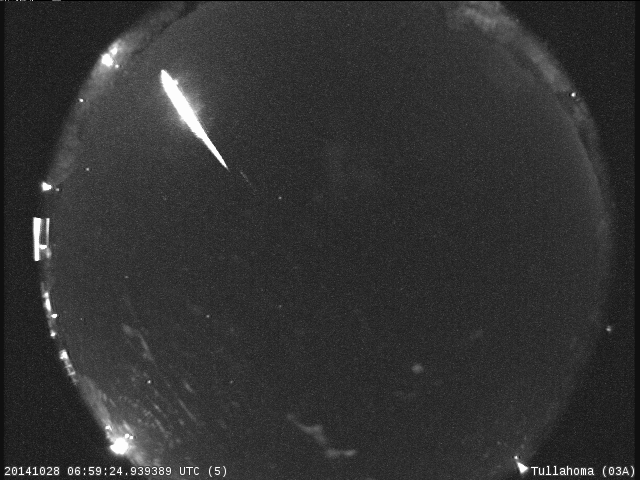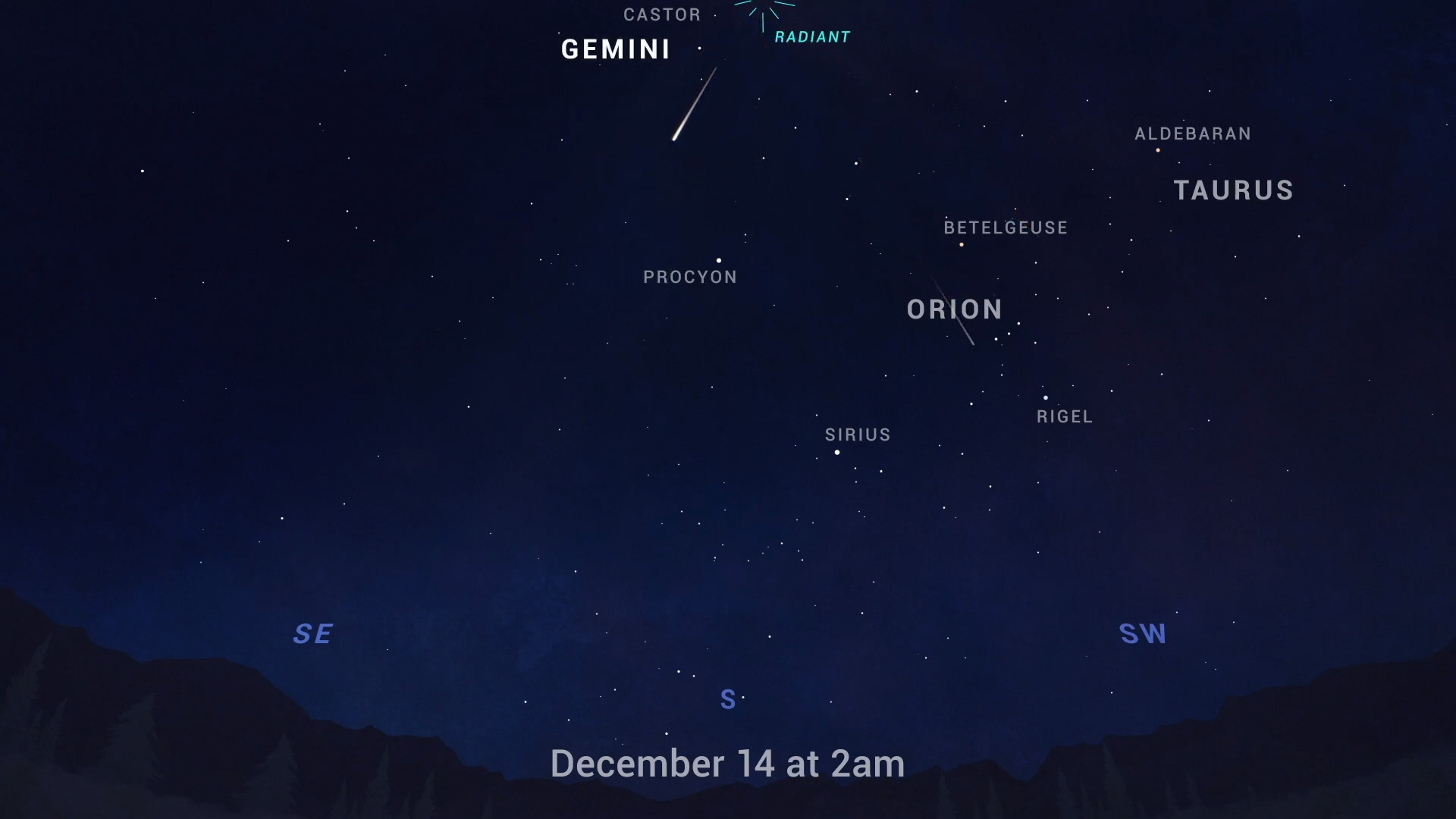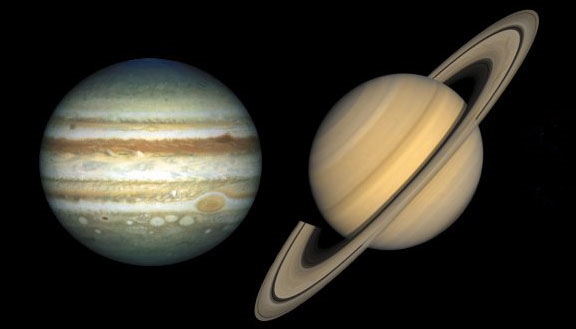What to Watch for in the Night Sky: End of the Year Edition
Special Stories
11 Nov 2020 6:30 AM
Unless you live in the deep south, pleasant overnights are well behind us. But, just because it may be cold, or really cold, doesn't mean the night sky is going to stop putting on a show for us terrestrials.
If you're lucky enough to live in a mild winter locale or you're just good at staying warm, here's a list of can't miss celestial events worth bundling up for through the end of the year, including the conjunction of Jupiter and Saturn in late December!
Spotting the International Space Station is always a great activity and is easy to do thanks to this handy tool. For detailed explanations and even more events, check out the “tonight” feature at EarthSky.
 A Taurid Fireball is caught on camera in Tullahoma Tennessee in 2014. (Credit: NASA)
The Taurids are typically visible from October through December of every year as Earth passes through the stream of debris left by Comet Encke. They typically don't produce high counts of meteors, but can certainly have brighter and more active shows at times. However, the Taurids are known for producing more bright fireballs than your typical shower, which may make viewing worth the chilly temperatures.
This year, the shower is expected to peak from the 11th into the morning of the 12th. It will likely only produce a few meteors per hour but the crescent moon should create clear and dark viewing conditions. Meteors will appear to emanate from the constellation Taurus, but like any meteor shower, it's best to try to watch a broad section of the sky.
A Taurid Fireball is caught on camera in Tullahoma Tennessee in 2014. (Credit: NASA)
The Taurids are typically visible from October through December of every year as Earth passes through the stream of debris left by Comet Encke. They typically don't produce high counts of meteors, but can certainly have brighter and more active shows at times. However, the Taurids are known for producing more bright fireballs than your typical shower, which may make viewing worth the chilly temperatures.
This year, the shower is expected to peak from the 11th into the morning of the 12th. It will likely only produce a few meteors per hour but the crescent moon should create clear and dark viewing conditions. Meteors will appear to emanate from the constellation Taurus, but like any meteor shower, it's best to try to watch a broad section of the sky.
 Leonid meteors appear to emanate from the constellation Leo. (Image credit: EarthSky.org)
The Leonids are known for the occasional meteor storm, with over 1000 meteors per hour. Unfortunately, that typically only happens every 33 years and this is not one of those years (the last storm occurred in 2001). Still, the new moon on November 15th will make this shower worth watching if you can stay warm and clouds don't obstruct the sky. Expect around 10-15 meteors per hour heading into the peak night (pre-dawn hours of November 17th).
Leonid meteors appear to emanate from the constellation Leo. (Image credit: EarthSky.org)
The Leonids are known for the occasional meteor storm, with over 1000 meteors per hour. Unfortunately, that typically only happens every 33 years and this is not one of those years (the last storm occurred in 2001). Still, the new moon on November 15th will make this shower worth watching if you can stay warm and clouds don't obstruct the sky. Expect around 10-15 meteors per hour heading into the peak night (pre-dawn hours of November 17th).
 Image credit: NASA
Asteroid or Dead Comet, 3200 Phaethon leaves plenty of dust in its wake that falls into Earth atmosphere to give us this fantastic show.
This year will have incredible viewing conditions since the new moon occurs on the 14th of December, during peak viewing! Try to get outside after midnight the morning of December 14th for your best chance to see lots of meteors. The mornings of December 13th and 15th should also produce good results this year. Find a dark place, away from city lights if possible, and try to watch as much of the sky as you can for best results.
Image credit: NASA
Asteroid or Dead Comet, 3200 Phaethon leaves plenty of dust in its wake that falls into Earth atmosphere to give us this fantastic show.
This year will have incredible viewing conditions since the new moon occurs on the 14th of December, during peak viewing! Try to get outside after midnight the morning of December 14th for your best chance to see lots of meteors. The mornings of December 13th and 15th should also produce good results this year. Find a dark place, away from city lights if possible, and try to watch as much of the sky as you can for best results.
 Image credit: NASA
Shortest day of the year AND the conjunction of the Solar System's two largest planets? Yes, please.
While the shortest day of the year isn't typically celebrated by many, the earlier setting sun means we'll have more time to see Jupiter and Saturn appear as one (or close to it) before they dip below the Western Horizon.
The Conjunction of Jupiter and Saturn happens about every 20 years, but this will be the closest the planets have appeared to earthlings since the 17th century, potentially as little as 7 arc minutes from each other (close to 0.1°) on the 21st, about 1/5th the apparent diameter of the moon.
You can watch these planets slowly get closer to one another in the months leading up to conjunction, culminating in their apparent touching in late December. Look to the west after sunset for the bright blobs that may appear as one bright blob. Binoculars and/or a telescope will help!
Image credit: NASA
Shortest day of the year AND the conjunction of the Solar System's two largest planets? Yes, please.
While the shortest day of the year isn't typically celebrated by many, the earlier setting sun means we'll have more time to see Jupiter and Saturn appear as one (or close to it) before they dip below the Western Horizon.
The Conjunction of Jupiter and Saturn happens about every 20 years, but this will be the closest the planets have appeared to earthlings since the 17th century, potentially as little as 7 arc minutes from each other (close to 0.1°) on the 21st, about 1/5th the apparent diameter of the moon.
You can watch these planets slowly get closer to one another in the months leading up to conjunction, culminating in their apparent touching in late December. Look to the west after sunset for the bright blobs that may appear as one bright blob. Binoculars and/or a telescope will help!
November
Taurid Meteor Shower (Nov 11 - 12)
 A Taurid Fireball is caught on camera in Tullahoma Tennessee in 2014. (Credit: NASA)
The Taurids are typically visible from October through December of every year as Earth passes through the stream of debris left by Comet Encke. They typically don't produce high counts of meteors, but can certainly have brighter and more active shows at times. However, the Taurids are known for producing more bright fireballs than your typical shower, which may make viewing worth the chilly temperatures.
This year, the shower is expected to peak from the 11th into the morning of the 12th. It will likely only produce a few meteors per hour but the crescent moon should create clear and dark viewing conditions. Meteors will appear to emanate from the constellation Taurus, but like any meteor shower, it's best to try to watch a broad section of the sky.
A Taurid Fireball is caught on camera in Tullahoma Tennessee in 2014. (Credit: NASA)
The Taurids are typically visible from October through December of every year as Earth passes through the stream of debris left by Comet Encke. They typically don't produce high counts of meteors, but can certainly have brighter and more active shows at times. However, the Taurids are known for producing more bright fireballs than your typical shower, which may make viewing worth the chilly temperatures.
This year, the shower is expected to peak from the 11th into the morning of the 12th. It will likely only produce a few meteors per hour but the crescent moon should create clear and dark viewing conditions. Meteors will appear to emanate from the constellation Taurus, but like any meteor shower, it's best to try to watch a broad section of the sky.
Leonid Meteor Shower (Nov 16 - 18)
 Leonid meteors appear to emanate from the constellation Leo. (Image credit: EarthSky.org)
The Leonids are known for the occasional meteor storm, with over 1000 meteors per hour. Unfortunately, that typically only happens every 33 years and this is not one of those years (the last storm occurred in 2001). Still, the new moon on November 15th will make this shower worth watching if you can stay warm and clouds don't obstruct the sky. Expect around 10-15 meteors per hour heading into the peak night (pre-dawn hours of November 17th).
Leonid meteors appear to emanate from the constellation Leo. (Image credit: EarthSky.org)
The Leonids are known for the occasional meteor storm, with over 1000 meteors per hour. Unfortunately, that typically only happens every 33 years and this is not one of those years (the last storm occurred in 2001). Still, the new moon on November 15th will make this shower worth watching if you can stay warm and clouds don't obstruct the sky. Expect around 10-15 meteors per hour heading into the peak night (pre-dawn hours of November 17th).
Full Moon and Penumbral Lunar Eclipse (Nov 30th)
Don't get too excited when you see the headlines about a lunar eclipse at the end of November. Sure, it's an eclipse, but it's a penumbral eclipse, which means the moon will only be passing through Earth's outer shadow. Instead of producing the deep red hues of an umbral eclipse, the moon will appear to darken slightly. You'll have to get up quite early to see it, the peak shading will occur around 4:43 a.m. Eastern Standard Time on the morning of November 30th, but it will be visible across all of the United States (including Alaska and Hawaii).December
Geminid Meteor Shower (Dec 13 - 14)
[embed]https://youtu.be/o_sr-Ncc3FU[/embed] Here we go! The Geminids are known as one of the best if not the best meteor shower of the year, if only it occurred when temperatures were more mild. (The above video from NASA shows some highlights from this fixed camera in 2018). During peak conditions, the Geminids can produce more than 100 colorful meteors per hour with about 50 or more expected during peak viewing this year. Unlike most meteor showers which originate from debris leftover by passing comets comets, the Geminids spawn from a strange asteroid known as 3200 Phaethon. Phaethon may be a "dead" comet, that's still up for debate, and has short orbital period of 1.4 years. Image credit: NASA
Asteroid or Dead Comet, 3200 Phaethon leaves plenty of dust in its wake that falls into Earth atmosphere to give us this fantastic show.
This year will have incredible viewing conditions since the new moon occurs on the 14th of December, during peak viewing! Try to get outside after midnight the morning of December 14th for your best chance to see lots of meteors. The mornings of December 13th and 15th should also produce good results this year. Find a dark place, away from city lights if possible, and try to watch as much of the sky as you can for best results.
Image credit: NASA
Asteroid or Dead Comet, 3200 Phaethon leaves plenty of dust in its wake that falls into Earth atmosphere to give us this fantastic show.
This year will have incredible viewing conditions since the new moon occurs on the 14th of December, during peak viewing! Try to get outside after midnight the morning of December 14th for your best chance to see lots of meteors. The mornings of December 13th and 15th should also produce good results this year. Find a dark place, away from city lights if possible, and try to watch as much of the sky as you can for best results.
Solstice and the Great Conjunction (December 21st)
 Image credit: NASA
Shortest day of the year AND the conjunction of the Solar System's two largest planets? Yes, please.
While the shortest day of the year isn't typically celebrated by many, the earlier setting sun means we'll have more time to see Jupiter and Saturn appear as one (or close to it) before they dip below the Western Horizon.
The Conjunction of Jupiter and Saturn happens about every 20 years, but this will be the closest the planets have appeared to earthlings since the 17th century, potentially as little as 7 arc minutes from each other (close to 0.1°) on the 21st, about 1/5th the apparent diameter of the moon.
You can watch these planets slowly get closer to one another in the months leading up to conjunction, culminating in their apparent touching in late December. Look to the west after sunset for the bright blobs that may appear as one bright blob. Binoculars and/or a telescope will help!
Image credit: NASA
Shortest day of the year AND the conjunction of the Solar System's two largest planets? Yes, please.
While the shortest day of the year isn't typically celebrated by many, the earlier setting sun means we'll have more time to see Jupiter and Saturn appear as one (or close to it) before they dip below the Western Horizon.
The Conjunction of Jupiter and Saturn happens about every 20 years, but this will be the closest the planets have appeared to earthlings since the 17th century, potentially as little as 7 arc minutes from each other (close to 0.1°) on the 21st, about 1/5th the apparent diameter of the moon.
You can watch these planets slowly get closer to one another in the months leading up to conjunction, culminating in their apparent touching in late December. Look to the west after sunset for the bright blobs that may appear as one bright blob. Binoculars and/or a telescope will help!All Weather News
More